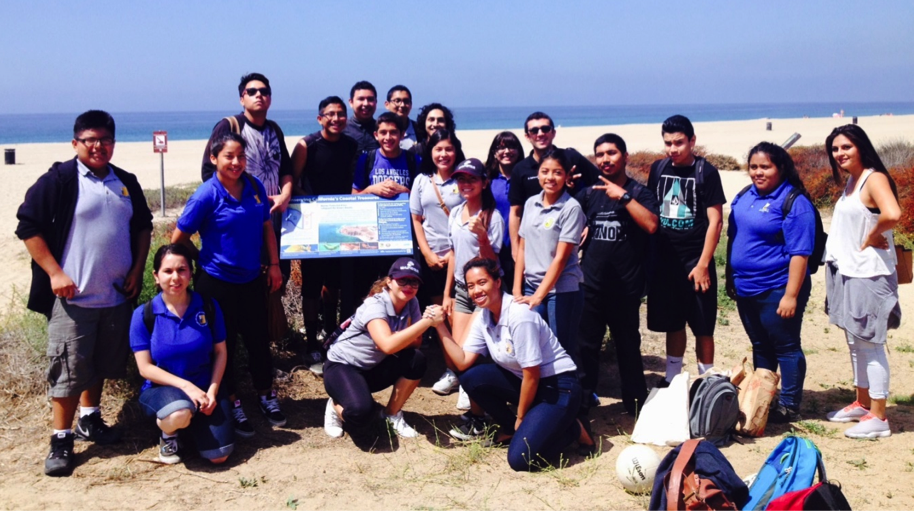A Good Sign for Local Marine Protected Areas
Staff scientist Dana Murray reports on our ongoing efforts to inform the public about the value and beauty of our local Marine Protected Areas.
Call them a sign of the times. Heal the Bay staff travelled along our local shorelines last week to help install informational displays about our fledgling Marine Protected Areas in Southern California.
Over three years in the making, the public signage informs beachgoers about the creation and importance of formally designated marine safe havens along the coastline — from San Diego to Santa Barbara, including our local MPAs in Malibu and Rancho Palos Verdes.
These beautiful and informative interpretive signs include maps, underwater images and bilingual descriptions of these underwater parks. California lays claim to the only statewide network of Marine Protected Areas (MPAs), where ocean wildlife can thrive with less disturbance from humans. Southern California’s MPAs have been in effect since 2012, following years of hard work by Heal the Bay and other coalition partners to implement them through the Marine Life Protection Act.
Illustrating the collaborative nature of MPA implementation, the sign project included a wide array of stakeholders and partners. Since 2012, Heal the Bay’s been working together with state agencies such as the Ocean Protection Council, Department of Fish and Wildlife, State Parks, and the Coastal Commission; Los Angeles MPA Collaborative members such as USC Sea Grant and Los Angeles Waterkeeper; cities such as Malibu and Rancho Palos Verdes; landowners such as Paradise Cove and L.A. County Beaches and Harbors; and other partner organizations such as the California Marine Sanctuary Foundation and Natural Resources Defense Council.
These organizations worked together to identify strategic sign locations, designed the content of the signs and provided Spanish translation, and procured landowner permission and coastal development permits to install the displays. All this work culminated in planting these signs in the sand late last week.
The first interpretive signs were installed Thursday at one of the world’s most popular coastal destinations — Malibu’s Zuma and Westward Beach, which is part of Point Dume State Marine Reserve and Point Dume State Marine Conservation Area. These beaches attract millions of visitors each year. The MPAs here encompass Point Dume’s rocky headland peninsula and deep sea canyon offshore, El Matador State Beach’s iconic rock arches, and a wide array of marine wildlife. Migrating gray whales often stop off and feed along Point Dume, and the reserve’s kelp forests, submarine canyon, and tide pools teem with octopus, anemones, and crabs. Historically, Point Dume’s kelp forest has been one of the largest in Southern California, providing food and shelter for a variety of sea life, including sea lions, lobster, grunion, and spawning squid.
Two years ago, we installed the first MPA regulatory signs in Los Angeles County along access points in Malibu and Palos Verdes, which simply reflect the new fishing regulations that accompany these MPAs. The newly designed educational signs installed this week will serve as a helpful public education tool, highlighting the importance of underwater parks and showing scenic underwater photos of the protected habitats and wildlife. Public education about our MPAs is imperative to help foster stewardship and advance MPA compliance.
Heal the Bay’s MPA Watch program surveys show that most people are respecting the new MPAs. However, a few hotspots exist where people are still fishing in reserves. Educational signs at key access points will help inform the public about where they can and cannot fish, while providing the important context as to why MPAs are beneficial to our coastal environment.
Earlier this year, Heal the Bay worked with partners to successfully pass new legislation that will strengthen enforcement of our state’s MPAs.
Beginning Jan. 1, Assemblywoman Lorena Gonzalez’ AB 298 will allow Department of Fish and Wildlife officers and other law enforcement agencies to combat poaching and illegal fishing in the MPAs off California’s coastline by issuing violators with a ticket – akin to a traffic violation – to enforce restrictions.
MPA violations are currently misdemeanor crimes and often prosecuted without priority. AB 298 gives officers the discretion to cite people that are illegally fishing in MPAs with an infraction or a misdemeanor, ensuring that lawbreakers are held accountable without placing a burden on the courts. AB 298 passed both the Assembly and the Senate on unanimous votes, and enjoyed widespread support from law enforcement, user groups and environmental organizations, including WILDCOAST, Heal the Bay, Monterey Bay Aquarium, San Diego Council of Divers, CA Fish and Game Wardens Association, California MPA Collaborative Implementation Project, and the Los Angeles District Attorney’s Office.
To join the statewide celebration of our MPAs, search your local MPA shoreline for these new interpretive signs, snap a picture, and post your photo on social media with #mpaswork and #healthebay.
To help with monitoring our local MPAs, join our upcoming MPA Watch training this October.
 Staff scientist Dana Murray, center, helped install new signs in Malibu.
Staff scientist Dana Murray, center, helped install new signs in Malibu.

A group of Los Angeles high schoolers stoked about their MPAs!


